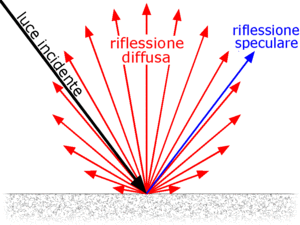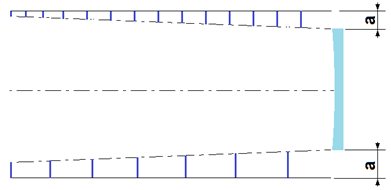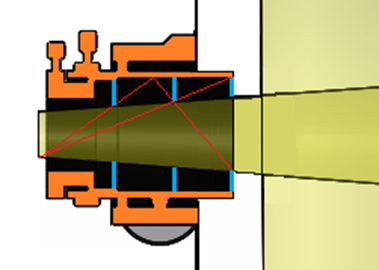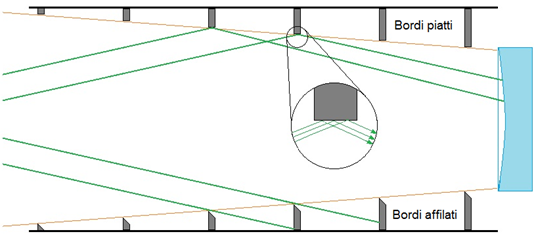POSITIONING OF SEPTA
Septa in the main pipe:
Once the length of the tube, you can begin to determine where they must be placed the internal baffles, to be able to block the off-axis light entering the telescope, and reflected or scattered from the inner surfaces, before this I can get on the primary mirror or focal plane.
 When a ray of light strikes the surface of an object, this reflects both in a diffused manner that speculate, and the relationship between the two is very dependent of the geometrical and physical characteristics of the same surface. There are various models to describe how the light is reflected in various directions, and choose which is the one that reflects as closely as the reality is not simple. but this, it is important if you do volgiano numerical detailed analysis of the baffle through special performance software, while as it regards the determination of the positioning of the baffles, that is the aspect that interests us most, You can be ignored in a first approximation.
When a ray of light strikes the surface of an object, this reflects both in a diffused manner that speculate, and the relationship between the two is very dependent of the geometrical and physical characteristics of the same surface. There are various models to describe how the light is reflected in various directions, and choose which is the one that reflects as closely as the reality is not simple. but this, it is important if you do volgiano numerical detailed analysis of the baffle through special performance software, while as it regards the determination of the positioning of the baffles, that is the aspect that interests us most, You can be ignored in a first approximation.
In the following video it is shown the procedure for determining the position of the baffles inside of the telescope tube. As you can see, the procedure is very simple and is certainly more understandable through the visual example than with the aid of a thousand words:
As we have seen in the video the location and extent of the septa is highly dependent on the internal diameter of the tube, or by the parameter "a". By varying this parameter will change, as well as the position of the baffles and their radial extension, Also their number. As you can see from the underlying, a tube of smaller diameter, part over (then with "a" minor), It requires a higher number of baffles to be able to reject the first reflection, compared to a solution with greater dimetro tube.

But a large number of septa, in addition to being costly from the construction point of view, It does not represent an optimal solution, as the edges of the baffles themselves represent a diffuse light source, that can not be in any way screen. So it is good to reduce the number to a minimum.
As always it happens so, we must seek a compromise solution, between the number of baffles and containment of the tube dimensions, that can not be exaggeratedly large in relation to the optical diameter, for obvious reasons of overall dimensions and transportability.
Setti in the barrel of the focuser:
The same is done for the main pipe, it can also extend to the tube focheffiatore.
In fact, the unwanted light, It can get to hit the inner wall of the barrel, thus it is reflected or diffused toward the focal plane. It 'so good predict small septa here, in the same manner described in the previous video.
It starts by placing the outermost septum at the end of the barrel, in such a way that goes to lick the desired field of view cone of light. From here you can start the positioning process of the other septa.
The limit beyond which they will not be positioned other septa, will be given by the fact that, none of the eye will have to crash on the last septum, when there is suitable to add it in the focuser.

It is important to note how the septa having inserted also inside the focuser barrel, It could allow to reduce the minimum height of the tube (explained earlier in the article 1/1), and therefore the maximum dimensions of the telescope.
PUT
Because the edges of the baffles are themselves sources of diffused light, We must pay particular care in the realization of the same, making them the finest and possible sharp. For stiffness reasons, it is not easy to realize the septa very fine and can not deform, then alternatively, You can be made with a certain thickness and then the inner edges smussarne wedge, then placing the flat face towards the exterior of the tube and the slanted part toward the mirror (as shown in Figure):

A septum often, with the flat edge, It possesses a circular surface on which the off-axis light can bounce without in any way be intercepted or screen, succeeding then you get on the primary mirror. Unlike these, the baffles with the sharp edge do not possess such surface, and the light, which it was previously reflected toward the mirror, now he continues its path until it meets the wall of the next septum, So being adequately screen.